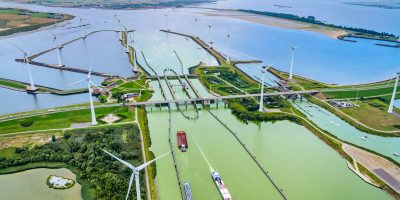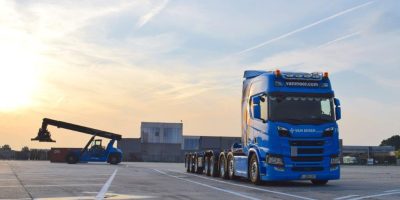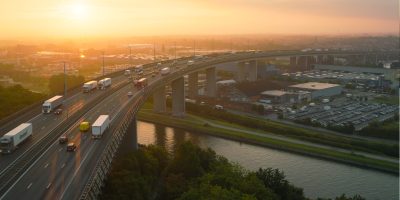
At the port of Antwerp, CMB.TECH is building the first dual-fuel hydrogen trucks. Although it will take an agonisingly long time before these can be allowed on the road, CMB.TECH believes in the technology. “Today we offer a viable and affordable solution for transporters who want to go green,” says CTO Roy Campe in the latest Flowsmagazine.
Hydrogen is the smallest and most abundant molecule, with a very high energy density. This makes it extremely suitable as an alternative fuel, according to CMB.TECH, the Antwerp-based maritime group. Spurred on by CEO Alexander Saverys, the traditional shipping group emerged as a pioneer in hydrogen technology, applicable not only for ships, but also for trains and trucks.
In the company’s workshop with hydrogen filling station at the Siberia Bridge in the port of Antwerp, ‘ordinary’ trucks are converted into dual-fuel trucks.
Green
“One of the big advantages of hydrogen is that it can be produced green,” Roy Campe stresses. “Based on green electricity, through the electrolysis of water, you can produce green hydrogen.” Campe refers to a green hydrogen project of the group in Namibia. There, CMB.TECH invested $30 million with Namibian family company Ohlthaver & List in a filling station with on-site green hydrogen production. This is generated with a park of more than 7,000 solar panels, because there is no shortage of sun in Namibia. In early May this year, King Philip went there to refuel the first dual-fuel truck with green hydrogen.
The dual-fuel truck in question had to come over from Antwerp, though, so there will not be an immediate rush for local green hydrogen in Namibia. In that respect, there is not that much difference with Antwerp: at the hydrogen filling station in Antwerp, there is no long queue either. “With hydrogen filling stations, it’s a bit of the chicken or the egg,” Campe responds. “In principle, you should have a hydrogen filling station every 100 km. Today there are seven in Belgium, and a minority of them can also serve trucks. In the Netherlands, there are 15, in Germany some 90, but barely half are suitable for trucks.”
First step
This is where CMB.TECH’s dual-fuel technology already provides an answer. “It is ideal for the energy transition we are in,” explains Roy Campe. “Dual-fuel technology today is feasible, affordable and reliable because you can always fall back on conventional fuel. Although we have set that as our end goal, today the customer is not asking for zero emissions, but for a certain reduction at the lowest possible price. Dual-fuel hydrogen is a way to take a first step already: the more hydrogen you use, the less diesel and therefore the fewer emissions.”
“Moreover, the principle of hydrogen as a fuel is the same; with CMB.TECH, we only install the hydrogen technology and supply on conventional trucks. The rest of the hardware, such as the engine, can simply be retained. With say, electric trucks, àll is different.”
Logistics player Van Moer took the plunge and placed a large order of 11 hydrogen dual-fuel trucks with CMB.TECH. Unfortunately, those trucks are still waiting for the necessary homologation. “We did underestimate that process a bit,” Campe admits. “We have to take into account not only the customer’s requests, but also the approvals of the truck being converted. If you start tinkering with that, you also have to reapply for certain homologations. For the government, this is a totally new technology, and they don’t want to take any chances. The whole process takes a particularly long time.”
Subsidies
It is the price CMB.TECH is paying for the pioneering role it is taking on. “After all, this is groundbreaking technology and we are grateful to the government for the support in the form of subsidies,” says Campe. “VLAIO awards a grant for 40% of the cost of the conversion, and you still have to count on €125,000 to switch from a regular drive to hydrogen dual-fuel.”
That extra cost is a drawback today. “The margins have fallen solidly and then you have an expensive conversion for the truck and also a more expensive fuel,” explains Roy Campe. “For many carriers, the bill is then quickly made.” This is why CMB.TECH is also betting on other vehicles. For instance, the company launched the first hydrogen-powered passenger boat a few years ago, and since December 2023 a hydrogen-powered tugboat has been operating in the port of Antwerp with the ‘Hydrotug’.
“In the port there is a lot of need for heavy equipment, and for that we want to provide a hydrogen application each time with CMB.TECH,” says Campe. “The technology is the same, and we can install it on tugs, trucks, but also straddle carriers, locomotives, and so on. Our ports are the hydrogen hotspots from which we will roll out this technology further.”




